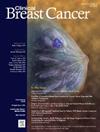Breast Cancer in Working-Age Men: A Population-Based Investigation of Global, Regional, and National Disease Burdens Between 1990 and 2021
IF 2.5
3区 医学
Q2 ONCOLOGY
引用次数: 0
Abstract
Background
The breast cancer (BC) disease burden in working-age men was investigated between 1990 and 2021.
Methods
Age-standardized incidence rates (ASIRs), prevalence rates ASPRs), and death rates (ASDRs), as well as age-standardized disability-adjusted life years rate (DALYs) on global, regional, and national levels between 1990 and 2021, were determined to assess the BC disease burden in working-age men (aged 15-64 years), together with risk factor and health inequality analyses.
Results
Globally, the ASIR, ASPR, ASDR, and age-standardized DALY rate in 2021 were 0.77 per 100,000 males (0.46‒0.99), 6.34 per 100,000 males (3.97‒8.02), 0.22 per 100,000 males (0.14‒0.28), and 8.75 per 100,000 males (5.58‒11.40), respectively. The burden of disease varied among regions and countries. Risk factor analysis revealed a marked influence of diets high in red meat on the ASDR and age-standardized DALY rate. Cross-national social inequality analysis identified marked inequalities, both relative and absolute, in the disease burden among regions, with higher burdens found in countries with lower sociodemographic indices.
Conclusions
The BC disease burden has escalated in men of working age, accompanied by a decline in life expectancy since the 1990s and increases in associated deaths and DALYs. Low-income regions exhibited a more substantial burden compared to high-income regions. The key to reducing the disease burden lies in enhancing national economic strength, with improvements in medical systems and the development of targeted clinical guidelines.
工作年龄男性乳腺癌:1990年至2021年间全球、地区和国家疾病负担的基于人群的调查
背景:对1990年至2021年间工作年龄男性乳腺癌(BC)疾病负担进行了调查。方法:确定1990年至2021年间全球、地区和国家层面的年龄标准化发病率(asir)、患病率(aspr)和死亡率(ASDRs)以及年龄标准化残疾调整生命年率(DALYs),以评估工作年龄男性(15-64岁)的BC疾病负担,并进行风险因素和健康不平等分析。结果:全球范围内,2021年ASIR、ASPR、ASDR和年龄标准化DALY率分别为0.77 / 10万(0.46-0.99)、6.34 / 10万(3.97-8.02)、0.22 / 10万(0.14-0.28)和8.75 / 10万(5.58-11.40)。各区域和国家的疾病负担各不相同。风险因素分析显示,高红肉饮食对ASDR和年龄标准化DALY率有显著影响。跨国社会不平等分析发现,各区域之间的疾病负担存在明显的相对和绝对不平等,社会人口指数较低的国家负担较高。结论:自20世纪90年代以来,工作年龄男性的BC疾病负担已经升级,伴随着预期寿命的下降以及相关死亡和伤残调整生命年的增加。与高收入地区相比,低收入地区的负担更为沉重。减轻疾病负担的关键在于提高国民经济实力,完善医疗体系,制定有针对性的临床指南。
本文章由计算机程序翻译,如有差异,请以英文原文为准。
求助全文
约1分钟内获得全文
求助全文
来源期刊

Clinical breast cancer
医学-肿瘤学
CiteScore
5.40
自引率
3.20%
发文量
174
审稿时长
48 days
期刊介绍:
Clinical Breast Cancer is a peer-reviewed bimonthly journal that publishes original articles describing various aspects of clinical and translational research of breast cancer. Clinical Breast Cancer is devoted to articles on detection, diagnosis, prevention, and treatment of breast cancer. The main emphasis is on recent scientific developments in all areas related to breast cancer. Specific areas of interest include clinical research reports from various therapeutic modalities, cancer genetics, drug sensitivity and resistance, novel imaging, tumor genomics, biomarkers, and chemoprevention strategies.
 求助内容:
求助内容: 应助结果提醒方式:
应助结果提醒方式:


